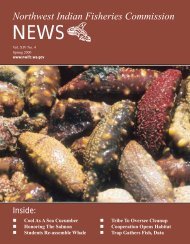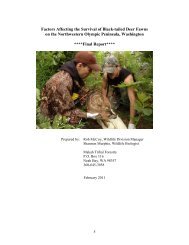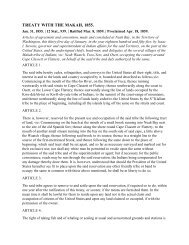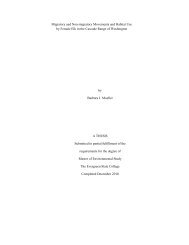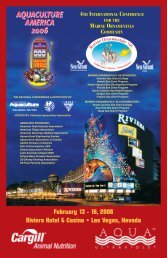NWIFC News - NWIFC Access - Northwest Indian Fisheries ...
NWIFC News - NWIFC Access - Northwest Indian Fisheries ...
NWIFC News - NWIFC Access - Northwest Indian Fisheries ...
You also want an ePaper? Increase the reach of your titles
YUMPU automatically turns print PDFs into web optimized ePapers that Google loves.
ilities<br />
lip laboratory technician, examines samples under a<br />
tribe’s new laboratory. Photo: K. Neumeyer<br />
Currently, the tribe has to send water<br />
samples off the reservation to be tested, to<br />
labs as far away as Oregon.<br />
The tribe typically samples water for<br />
fecal coliform and other bacteria as well<br />
as excessive nutrients, such as nitrogen<br />
from fertilizers. High levels of nutrients<br />
fuel algae blooms in Hood Canal, causing<br />
dissolved oxygen levels to plunge.<br />
Figlar-Barnes and Amiotte hope scientists<br />
from state and federal agencies<br />
will use the lab to analyze samples from<br />
Hood Canal and other nearby waterways.<br />
Funding for the lab came from the U.S.<br />
Environmental Protection Agency.<br />
Combined with 100 percent<br />
otolith marking of all<br />
chinook and coho salmon,<br />
all Tulalip hatchery production<br />
is uniquely marked<br />
and identifiable.<br />
Hatchery operators give<br />
otoliths a “thermal mark” by<br />
alternating the temperature<br />
of the water flowing over<br />
salmon eggs and hatched fry.<br />
The temperature fluctuation<br />
leaves a distinctive mark on<br />
the ear bone.<br />
“Without the ability to assess<br />
these stocks, we wouldn’t know<br />
how many wild and hatchery<br />
fish there are in the Snohomish<br />
basin or in the region,”<br />
said Mike Crewson, fisheries<br />
enhancement biologist.<br />
To aid shellfish management,<br />
for example, shellfish specialist<br />
Adam “Rocky” Brisbois uses the new<br />
equipment to count the rings on geoduck<br />
shells to determine their age.<br />
Crewson obtained the lab equipment<br />
for the new facility using limited grant<br />
sources and direct contributions of some<br />
equipment and supplies. Funding was<br />
provided through grants from the Tulalip<br />
Tribes Board of Directors, Tulalip Tribes<br />
Shellfish Program, Bureau of <strong>Indian</strong> Affairs<br />
and <strong>Northwest</strong> <strong>Indian</strong> College.<br />
The U.S. Geological Survey has continued<br />
to provide Tulalip with otolith<br />
analysis training. The University of<br />
Washington’s chemistry department is<br />
building a specialized grinder for the<br />
lab, and the tribes purchased the chemistry<br />
department’s surplus countertops<br />
and sinks.<br />
“Eventually, the stock assessment lab<br />
will allow us to eliminate the cost and<br />
time delays of sending our samples to<br />
outside labs,” Crewson said.<br />
– D. Preston, T. Royal<br />
& K. Neumeyer<br />
Tulalip Tribes<br />
The Tulalip Tribes have a new laboratory<br />
where natural resource specialists can<br />
analyze the fish and shellfish samples used<br />
to shape fisheries management.<br />
The lab equipment enables the specialists<br />
to study information contained in otoliths<br />
(salmon ear bones), fish scales and coded<br />
wire tags to determine factors such as the<br />
age and source of hatchery fish, migration<br />
patterns and other information.<br />
Equipment and supplies also are being<br />
acquired to identify the unique genetic mark<br />
given to all Tulalip hatchery chum salmon.<br />
Skokomish Tribe environmental program assistant Jen Green takes a water sample<br />
from Hood Canal. Photo: Skokomish Tribe



